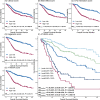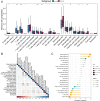ATHENA: an independently validated autophagy-related epigenetic prognostic prediction model of head and neck squamous cell carcinoma
- PMID: 37296474
- PMCID: PMC10257287
- DOI: 10.1186/s13148-023-01501-0
ATHENA: an independently validated autophagy-related epigenetic prognostic prediction model of head and neck squamous cell carcinoma
Abstract
The majority of these existing prognostic models of head and neck squamous cell carcinoma (HNSCC) have unsatisfactory prediction accuracy since they solely utilize demographic and clinical information. Leveraged by autophagy-related epigenetic biomarkers, we aim to develop a better prognostic prediction model of HNSCC incorporating CpG probes with either main effects or gene-gene interactions. Based on DNA methylation data from three independent cohorts, we applied a 3-D analysis strategy to develop An independently validated auTophagy-related epigenetic prognostic prediction model of HEad and Neck squamous cell carcinomA (ATHENA). Compared to prediction models with only demographic and clinical information, ATHENA has substantially improved discriminative ability, prediction accuracy and more clinical net benefits, and shows robustness in different subpopulations, as well as external populations. Besides, epigenetic score of ATHENA is significantly associated with tumor immune microenvironment, tumor-infiltrating immune cell abundances, immune checkpoints, somatic mutation and immunity-related drugs. Taken together these results, ATHENA has the demonstrated feasibility and utility of predicting HNSCC survival ( http://bigdata.njmu.edu.cn/ATHENA/ ).
Keywords: Autophagy; DNA methylation; Gene–gene interaction; Head and neck squamous cell carcinoma; Immune landscape; Prognostic prediction.
© 2023. The Author(s).
Conflict of interest statement
The authors declare that they have no conflict of interest.
Figures









Similar articles
-
Signature Based on Six Autophagy-related Genes to Predict Prognosis of Head and Neck Squamous Cell Carcinoma.Curr Med Sci. 2022 Jun;42(3):597-605. doi: 10.1007/s11596-022-2560-1. Epub 2022 Jun 1. Curr Med Sci. 2022. PMID: 35648284
-
Identification and validation of a prognostic signature of autophagy, apoptosis and pyroptosis-related genes for head and neck squamous cell carcinoma: to imply therapeutic choices of HPV negative patients.Front Immunol. 2023 Jan 10;13:1100417. doi: 10.3389/fimmu.2022.1100417. eCollection 2022. Front Immunol. 2023. PMID: 36703967 Free PMC article.
-
Ferroptosis-associated DNA methylation signature predicts overall survival in patients with head and neck squamous cell carcinoma.BMC Genomics. 2022 Jan 18;23(1):63. doi: 10.1186/s12864-022-08296-z. BMC Genomics. 2022. PMID: 35042463 Free PMC article.
-
Targeting Epigenetic Dysregulations in Head and Neck Squamous Cell Carcinoma.J Dent Res. 2025 Mar;104(3):225-234. doi: 10.1177/00220345241297122. Epub 2024 Dec 19. J Dent Res. 2025. PMID: 39698794 Review.
-
[Prognostic and predictive methylation biomarkers in HNSCC : Epigenomic diagnostics for head and neck squamous cell carcinoma (HNSCC)].HNO. 2020 Dec;68(12):911-915. doi: 10.1007/s00106-020-00902-4. HNO. 2020. PMID: 32613323 Review. German.
Cited by
-
A two-phase epigenome-wide four-way gene-smoking interaction study of overall survival for early-stage non-small cell lung cancer.Mol Oncol. 2025 Jan;19(1):173-187. doi: 10.1002/1878-0261.13766. Epub 2024 Dec 4. Mol Oncol. 2025. PMID: 39630602 Free PMC article.
-
ARTEMIS: An independently validated prognostic prediction model of breast cancer incorporating epigenetic biomarkers with main effects and gene-gene interactions.J Adv Res. 2025 Jul;73:561-573. doi: 10.1016/j.jare.2024.08.015. Epub 2024 Aug 11. J Adv Res. 2025. PMID: 39137864 Free PMC article.
-
Impact of HMGA1 on tumorigenesis, prognosis and immune microenvironment in HNSCC: a multi-omics study.NPJ Precis Oncol. 2025 Aug 2;9(1):269. doi: 10.1038/s41698-025-01068-4. NPJ Precis Oncol. 2025. PMID: 40753128 Free PMC article.
References
Publication types
MeSH terms
LinkOut - more resources
Full Text Sources
Medical

